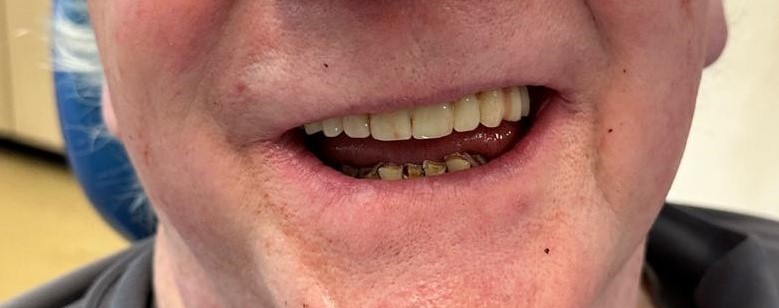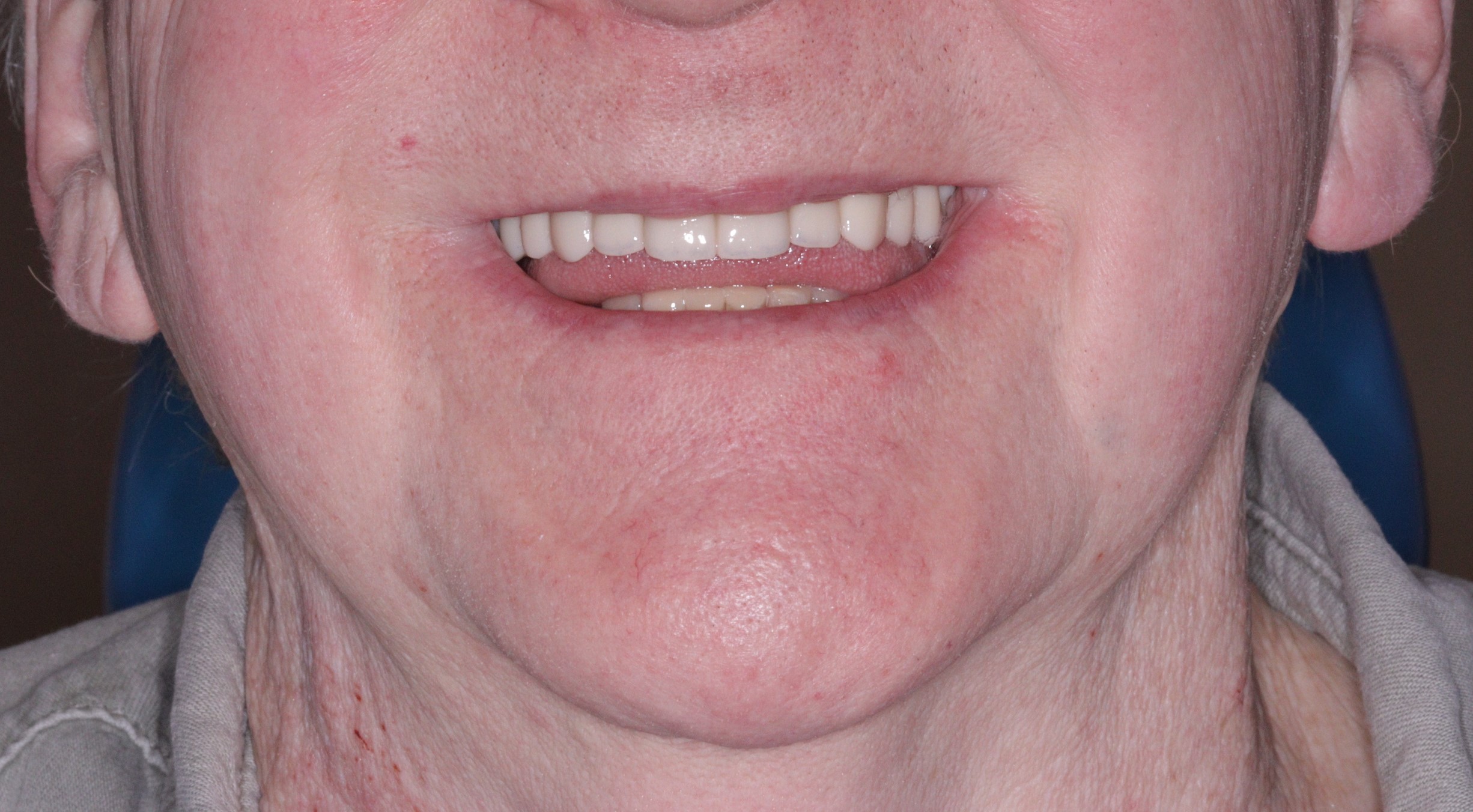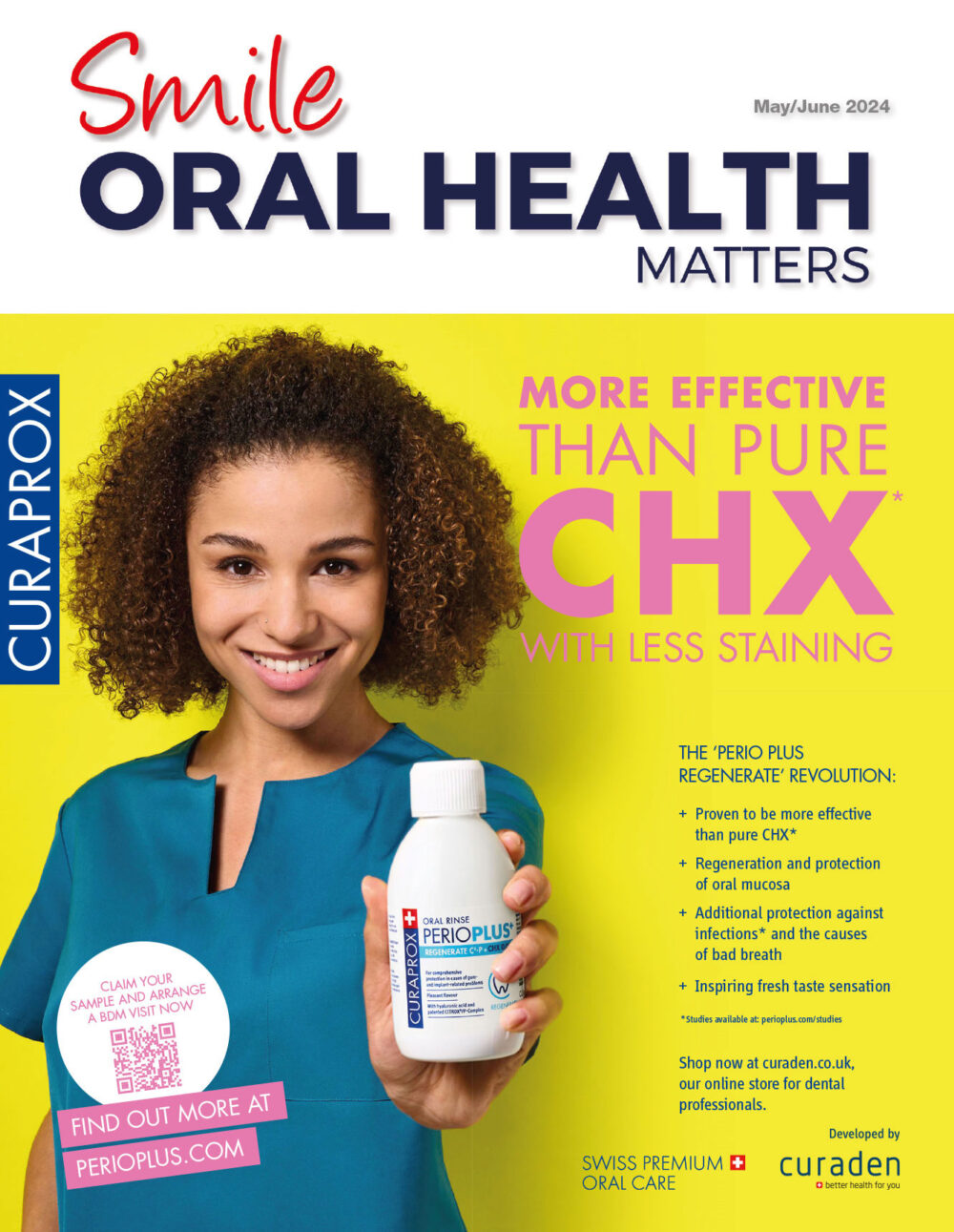Dr Henry Cairns presents a recent full arch rehabilitation utilising cutting-edge digital solutions elevate the final result and significantly reduce treatment time.
Patient presentation
A 71-year-old male patient was referred by another dentist in the practice. His chief complaint was a lack of remaining teeth in the upper arch and he expressed sincere dislike of their appearance. The patient was initially seeking a fixed upper solution, although discussion was also had about improving the lower teeth too at a later date.
Presenting smile
Clinical assessment
A full assessment was conducted to evaluate the treatment options available. There were six teeth remaining in the upper arch, although most were broken or fractured with poor prognoses. This indicated full arch rehabilitation.
A full suite of clinical photographs, intraoral scans and a CT scan were taken. The option of either a removable or implant-retained denture was discussed in detail with the patient, who favoured a fixed solution.
A digital planning workflow
With Clyde Munro, clinicians have access to the CHROME GuidedSmile workflow, which is designed to increase efficiencies and save time during the implant treatment planning process. For this case, the scans were uploaded to the software and the ideal implant positions, depths and angles were identified. The laboratory also produced a smile simulation, which afforded the patient the benefit of seeing what his smile may look like post-treatment.
With the patient’s informed consent, the treatment plan was approved and a series of stackable guides were designed and fabricated, providing a framework to follow for the surgery. This would involve the placement of six implants in the upper arch, fitted with an implant-retained full arch prosthesis.
Digital planning of implant placement
CHROME GudiedSmile guide in place
Restoring the smile in a day
On the day of treatment, the procedure was once again outlined for the patient. Local anaesthetic was administered to the upper arch and a full thickness flap was raised. The CHROME GuidedSmile base guide was placed in the mouth, over the teeth, and pinned into place.
The existing teeth were then extracted as atraumatically as possible. Bone reduction was also performed at this time, using the designated guide to facilitate the removal of hard tissue until the top of the bony structure was flat against the guide. Next in the sequence was the drilling guide, which was placed onto the existing framework. The osteotomies were created by drilling through the relevant guide to ensure accuracy.
Six BTI Interna Narrow implants – including five 4mm x 11.5mm implants and one 4.25mm x 8.5mm – were then placed, once again through the guide to precisely achieve the predetermined positions, depths and angles.
The CHROME GuidedSmile drilling guide was then removed and replaced with the prosthetic guide. Two prosthetics are made as part of this workflow prior to the patient visiting for surgery; one is for the patient to wear home as a provisional and the other – known as the rapid appliance – is kept at the practice and used to fabricate the final restoration.
The temporary prosthetic was picked up through the relevant guide and tried in the mouth. With no immediate concerns presenting, the provisional is removed for suturing of the surgical sites and replaced for the patient to leave with a full dentition. The patient was given standard post-operative instructions relating to oral hygiene and diet, and he was out the door approximately three hours after arriving at the practice with an entirely new smile.
Outcome
A review was conducted two weeks later, during which the sutures were removed and the provisional restoration checked. Healing continued as expected and upon review after four more months, the patient was ready for the final restoration.
The workflow was straightforward thanks to the CHROME GuidedSmile protocols. The rapid appliance was placed in the mouth and an analogue impression was taken of underneath the device to pick up the soft tissue contour post-healing. A bite registration was also taken at this time, before replacing the other provisional. These are the only conventional steps in an otherwise entirely digital workflow. The final prosthesis – a zirconia bridge – was fabricated and placed.
Treatment concluded with some composite build ups on the lower teeth to optimise aesthetics and the patient was thrilled with the outcome.

Post-operative temporary prosthesis

Post treatment outcome
Discussion points
When moving into full arch rehabilitation, it is useful to follow a specific protocol such as the CHROME GuidedSmile workflow. It makes the process more predictable, without any surprises or unnecessary complications on the day of surgery. Every step is pre-planned and the clinician need only work through the sequence of guides. This also reduces surgical time, which can otherwise be substantial for full arch cases, which benefits both patient and practitioner.
For clinicians moving into full arch cases, good communication with the lab is crucial. If they can be involved from the planning phase, this will facilitate smoother workflows for all and better outcomes. For any cases that are beyond your remit as a clinician, referral remains key.
Author: Dr Henry Cairns
Henry graduated from the University of Dundee in 2016 as a Dental Therapist. He then went on to study at the University of Aberdeen to become a Dentist and graduated in 2020. Henry has a diploma in Implant Dentistry and has a special interest in this field.



















